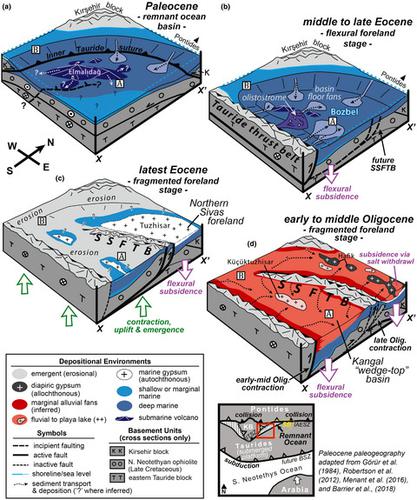当前位置:
X-MOL 学术
›
Basin Res.
›
论文详情
Our official English website, www.x-mol.net, welcomes your
feedback! (Note: you will need to create a separate account there.)
Palaeogene stratigraphy and chronology of the western Sivas Basin, central Anatolia (Turkey): Tectono‐sedimentary evolution of a well‐preserved basin along the northern Neotethys suture zone
Basin Research ( IF 2.8 ) Pub Date : 2020-08-05 , DOI: 10.1111/bre.12498 Michael H. Darin 1, 2 , Paul J. Umhoefer 1
Basin Research ( IF 2.8 ) Pub Date : 2020-08-05 , DOI: 10.1111/bre.12498 Michael H. Darin 1, 2 , Paul J. Umhoefer 1
Affiliation

|
The Sivas Basin overlaps the northern Neotethys suture zone in central Anatolia (Turkey) and contains a ca. 12‐km thick succession of Cenozoic strata that provides an exceptional record of major tectonic transitions from subduction to continental assembly and tectonic escape. Consensus regarding the tectonic and palaeogeographic evolution of this segment of the Arabia‐Eurasia collision zone has been hindered by uncertainty in the tectonic setting of the early (Palaeogene) Sivas Basin, which has been variably interpreted as a remnant ocean, forearc, foreland, wedge‐top or intracontinental extensional basin. Here we integrate new geologic mapping (>5,000 km2), stratigraphy, facies analysis and U‐Pb geochronology from the western Sivas Basin to produce a detailed time‐stratigraphic framework and a refined Palaeogene tectono‐sedimentary model for the Sivas Basin. Earliest marine sedimentation occurred during the Maastrichtian‐Palaeocene in a remnant ocean setting due to incomplete closure of the northern Neotethys Ocean. Rapid accumulation of >2 km of basin floor turbidites during the middle to late Eocene reflect a transition to a foreland setting. A major late Eocene unconformity (ca. 38–34 Ma) coincides with the initiation of the north‐vergent southern Sivas fold‐thrust belt, which inverted and structurally partitioned the basin into a southern wedge‐top and a northern evaporitic foreland basin; the entire basin was dominantly nonmarine after this unconformity. Published palaeomagnetic data integrated with a newly discovered tuff dated at 31.9 Ma reveal that the 2.8‐km thick Altinyayla Formation was deposited from ca. 34 to 26 Ma in an unconfined braided fluvial system. Close stratigraphic correlations between the western, central and northern Sivas Basin suggest that the entire basin evolved from a remnant ocean to peripheral retro‐foreland basin during the middle to late Eocene, and finally a fragmented foreland basin since the Oligocene. This general evolution may be a characteristic of such sedimentary basins formed on suture zones across Anatolia and in other collisional orogens globally.
中文翻译:

安纳托利亚中部(土耳其)锡瓦斯盆地西部的古近纪地层和年代学:沿新特提斯缝合带北部保存完好的盆地的构造沉积沉积演化
锡瓦斯盆地与安纳托利亚(土耳其)中部北部的新特提斯缝合带重叠,并包含一个约。新生代地层的12 km厚的层序提供了从俯冲到大陆组装和构造逃逸的主要构造过渡的出色记录。早期(古近纪)锡瓦斯盆地构造环境的不确定性阻碍了有关阿拉伯-欧亚大陆碰撞带这一段构造和古地理演化的共识,该地区被可变地解释为残余的海洋,前臂,前陆,楔形。顶部或洲内伸展盆地。在这里,我们集成了新的地质图(> 5,000 km 2),地层,相分析和锡瓦斯盆地西部的U-Pb地质年代学,以为锡瓦斯盆地产生详细的时间地层框架和精细的古近纪构造-沉积模型。由于北部新特提斯洋海的不完全封闭,最早的海洋沉积发生在马斯特里赫特-古新世的残余海洋环境中。在始新世中期到晚期,盆底浊积体> 2 km的快速堆积反映了向前陆环境的过渡。始新世的一次严重不整合(约38-34 Ma)与北部北部南部Sivas褶皱冲断带的形成相吻合,该盆地将盆地反转并在结构上划分为南部楔顶和北部蒸发前陆盆地。在这种不整合之后,整个盆地主要是非海洋的。已发布的古磁数据与新发现的凝灰岩(日期为31.9 Ma)集成在一起,表明2.8 km厚的Altinyayla组是从约旦河沉积的。在无限制的辫状河床系统中为34至26 Ma。西部,中部和北部锡瓦斯盆地之间的紧密地层相关性表明,整个盆地在始新世中期至晚期从残余海洋演化为外围的前陆盆地,最后是渐新世以来的破碎前陆盆地。这种总体演变可能是这样的沉积盆地的特征,这些沉积盆地形成于整个安纳托利亚的缝合线上以及全球其他碰撞造山带中。西部,中部和北部锡瓦斯盆地之间的紧密地层相关性表明,整个盆地在始新世中期至晚期从残余海洋演化为外围的前陆盆地,最后是渐新世以来的破碎前陆盆地。这种总体演变可能是这样的沉积盆地的特征,这些沉积盆地形成于整个安纳托利亚的缝合线上以及全球其他碰撞造山带中。西部,中部和北部锡瓦斯盆地之间的紧密地层相关性表明,整个盆地在始新世中期至晚期从残余海洋演化成外围的前陆后盆地,最后是渐新世以来破碎的前陆盆地。这种总体演变可能是这样的沉积盆地的特征,这些沉积盆地形成于整个安纳托利亚的缝合线上以及全球其他碰撞造山带中。
更新日期:2020-08-05
中文翻译:

安纳托利亚中部(土耳其)锡瓦斯盆地西部的古近纪地层和年代学:沿新特提斯缝合带北部保存完好的盆地的构造沉积沉积演化
锡瓦斯盆地与安纳托利亚(土耳其)中部北部的新特提斯缝合带重叠,并包含一个约。新生代地层的12 km厚的层序提供了从俯冲到大陆组装和构造逃逸的主要构造过渡的出色记录。早期(古近纪)锡瓦斯盆地构造环境的不确定性阻碍了有关阿拉伯-欧亚大陆碰撞带这一段构造和古地理演化的共识,该地区被可变地解释为残余的海洋,前臂,前陆,楔形。顶部或洲内伸展盆地。在这里,我们集成了新的地质图(> 5,000 km 2),地层,相分析和锡瓦斯盆地西部的U-Pb地质年代学,以为锡瓦斯盆地产生详细的时间地层框架和精细的古近纪构造-沉积模型。由于北部新特提斯洋海的不完全封闭,最早的海洋沉积发生在马斯特里赫特-古新世的残余海洋环境中。在始新世中期到晚期,盆底浊积体> 2 km的快速堆积反映了向前陆环境的过渡。始新世的一次严重不整合(约38-34 Ma)与北部北部南部Sivas褶皱冲断带的形成相吻合,该盆地将盆地反转并在结构上划分为南部楔顶和北部蒸发前陆盆地。在这种不整合之后,整个盆地主要是非海洋的。已发布的古磁数据与新发现的凝灰岩(日期为31.9 Ma)集成在一起,表明2.8 km厚的Altinyayla组是从约旦河沉积的。在无限制的辫状河床系统中为34至26 Ma。西部,中部和北部锡瓦斯盆地之间的紧密地层相关性表明,整个盆地在始新世中期至晚期从残余海洋演化为外围的前陆盆地,最后是渐新世以来的破碎前陆盆地。这种总体演变可能是这样的沉积盆地的特征,这些沉积盆地形成于整个安纳托利亚的缝合线上以及全球其他碰撞造山带中。西部,中部和北部锡瓦斯盆地之间的紧密地层相关性表明,整个盆地在始新世中期至晚期从残余海洋演化为外围的前陆盆地,最后是渐新世以来的破碎前陆盆地。这种总体演变可能是这样的沉积盆地的特征,这些沉积盆地形成于整个安纳托利亚的缝合线上以及全球其他碰撞造山带中。西部,中部和北部锡瓦斯盆地之间的紧密地层相关性表明,整个盆地在始新世中期至晚期从残余海洋演化成外围的前陆后盆地,最后是渐新世以来破碎的前陆盆地。这种总体演变可能是这样的沉积盆地的特征,这些沉积盆地形成于整个安纳托利亚的缝合线上以及全球其他碰撞造山带中。











































 京公网安备 11010802027423号
京公网安备 11010802027423号